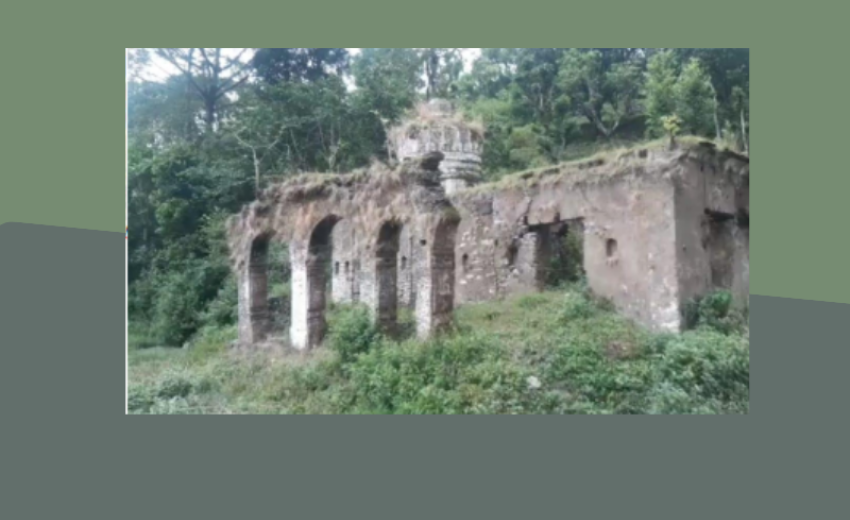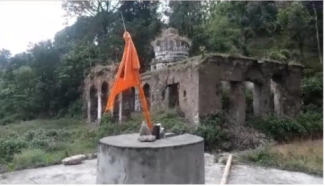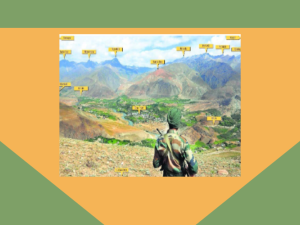After visiting Paunta Sahib and Bhangani our plan was to go to Kalsi and Atleo. These two villages are across the Jamuna. Kalsi was the historical shrine of Guru Gobind Singh and in Atleo Guru Gobind Singh is worshiped as the deity in the temple. Kalsi is 10 kms from Bhangani and the road goes further to Atleo village through Kalsi.
Kalsi, is a small village in Uttarakhand, 44 km from Dehradun and 43 km from Chakrata.. The post office is Kalyana and the district is Dehradun. It is thus situated between the Dehradun-Chakrata hill stations. It is situated at the confluence of Yamuna and Tons rivers on the banks of the Yamuna River. at an altitude of 780 meters. It falls on the old route to the Yamunotri, the source of the Yamuna River. Quietly nestled amidst vast hills and plateaus, Kalsi attracts passers-by with its majestic beauty. It lies between Uttarakhand and Himanchal mountains.
This place is also known as the gateway of Jaunsar-Bawar tribal area of Dehradun district. It is inhabited by Khil, Bhutia and Mundar communities with a rural look and homely feel. Surrounded by lush oak and teak trees and a vast green valley, this small place offers you a mesmerizing view of the Garhwal Himalayan ranges.
Route to Kalsi from Bhangani
Kalsi is famous for various ancient monuments, adventure sports and picnic sites. A rock inscription of the time of Emperor Ashoka, an important monument in the history of Indian epigraphy is a popular tourist attraction of Kalsi. This is the rock on which the Fourteenth Edict of the Mauryan King Ashoka was carved in 253 BCE. The edict expresses a commitment to non-violence and policies for the prohibition of war in the Prakrit language and Brahmi script.
Old inscriptions preserved in small building in Kalsi
The height and width of the structure are 10 feet and 8 feet respectively. It is now preserved by the Archeology Department of India. It is known for the Rock Edicts of Kalsi, a group of major inscriptions of Emperor Ashoka. Igneous rock consists of 1 to 14 edits of parent rock.
During winters, the cold air and cool weather rejuvenates you offering the best views and mesmerizing experiences of the white snow laden Himalayas. To reach by air regular flight from Delhi is to Jolly Grant Airport Dehradun. Tourists can take a taxi or hire a car to Kalsi from the Jolly Grant Airport. By Rail Dehradun Railway Station Govind Nagar is connected to all major parts of India. It is 43.5 km from Kalsi village. One can take city bus, car or taxi from Dehradun railway station.
Sikh History of Kalsi
Kalsi is close to Paunta Sahib and Bhangani. Paunta Sahib is on the border of Uttarakhand, Himachal Pradesh and Haryana where there are many Gurdwaras in memory of the tenth Sikh Guru, Guru Gobind Singh Ji fought In Bhangani, against the Mughals and the hill Rajas. Now four Gurdwaras in Bhangani commemorate the event. Kalsi village was built by Kalsi Rikhi. On his nam, this village is named Kalsi Village is now in divided into two parts; an old Kalsi and a new Kalsi. Guruji had earlier come and stayed in Old Kalsi at the Shiva temple where he had come across the Kalsi Rikhi. (Dhana Singh Chahal, p. 166, 12 June 1931)
We proceeded to Kalsi on 23rd June 2023 in our car, leaving Bhangani for Kalsi at 9 AM. From Dakpathar we took the Chakrata National Highway and New Kalsi soon arrived. When we asked about the Gurdwara Sahib, we were told that the Gurdwara is in the old Kalsi. Both Kalsi’s are located on the Highway from Nahan-Paunta-Chakrata which passes through both.. While going from Paunta Sahib/Bhangani the new Kalsi comes first followed by the old Kalsi, which is a little off the m,ain road. Two kilometers further from New Kalsi is Old Kalsi. As told, we drove on the road for two kilometers and turned to the Kutcha road turning to the right, i.e. towards the south.
A little further from Government Inter School, Kalsi, we asked the way to the Gurdwara. An old man who appeared to be a Punjabi and spoke in Punjabi with us also asked us to park the car in a little open space adjoining tehsil office. I parked the car and walked towards the old man who mentioned about the small lane in front of his shop, going to Gurdwara.
A little further back was a small lane with a tiled road leading westward to a hilly path ahead. I was ahead and my life partner, Gurcharan was behind. The slope was getting dangerous. A small rivulet was seen below, on the bank of which the Gurdwara Sahib was stated to be. A lone house was seen in a dilapidated condition, but there was no sign of the Gurdwara Sahib even near it. A little to the north, Nishan Sahib was seen along the stream of the river, but there was no path to go there.
We walked on the open spaces of the fields and reached the place where there was a Nishan Sahib of the Gurdwara Sahib on the bank of the rivulet. The Nishan Sahib sign was on a small stick and it was crooked. I tried to straighten it but the heavy stones were stuck in it in such a way that it could not be straightened. The large pole of the Nishan Sahib was lying on the ground. The Gurdwara was in a totally dilapidated condition. There were three rooms, two of which were completely collapsed and grass, weeds and reeds were standing in them. One room was a bit ok but it didn't seem like Sri Guru Granth Sahib had ever been placed there or a kirtan program had taken place or Sangat had come to pay obeisance to the place.
I took photos and video of this collapsed building and started going back. While climbing up, suddenly two bulls came rushing down from above. Gurcharan and I jumped to a side and saved ourselves. We saw a girl following these bulls. We stopped here and wanted to know about the Gurdwara. She gave no answer. Either she did not know anything about it or was prevented from speaking. While climbing, however, she helped Gurcharan who appeared to be facing problem climbing the steep climb.
Historical Gurdwara Manji Sahib Guru Gobind Singh in a dilapidated condition
“All the Kalsi people know that this Gurdwara Manji Sahib is in memory of Guru Gobind Singh Ji who came here, visited the temples and redeemed Kalkhi Rishi. But when this Gurdwara was destroyed no one came to protect it, but took part in looting the property of the Gurdwara.
This old man was from the family of Bhai Mati Das ji who was martyred along with Guru Tegh Bahadur Sahib. He and his family was from a military background, who were a displaced family from Pakistan. The family wandered from place to place after having displaced from Hazara in the year 1947 and ended up living by running a small shop in Kalsi. Now his shop was doing well. Being related to Guru’s Sikhs, he had a special attachment to Gurdwara Sahib. His shop was also at the place where the Gurdwara Sahib Street turned from the market.
In the year 1984, some local bad elements looted and demolished the Gurdwara Sahib. He filed a case in the court, but due to no support and the influence of bad elements, he could not do anything. He went to Paonta Sahib and appealed to the management, but nothing happened, and this historical place gradually turned in to ruin.
It is a matter of great shame for the Sikh nation that it could not maintain its historical places. I remember Gurdwara Almora Sahib, Gurdwara Nanak Bari and another Gurdwara near Ritha Sahib where Guru Nanak Dev ji had set his feet were put on fire in 1984 but no concrete steps were taken. Similarly, an attempt was made to erase the memories of Gurdwara Nanak Sahib from Haridwar by changing Gurdwara Nanak Bari into a Mandir and converting the main Gurdwara of Haridwar Ghat into a government institution. Gurdwara Guru Dongmar in Sikkim and Gurdwara Guru Nanak Taposthan Manchukha were taken over by Tibetan Buddhists. Two Gurdwaras belonging to Guru Nanak Dev ji were demolished in Puri Orissa. In Nasik in Sri Ram Ghat on the bank of Godavari a gurdwara built by Maharaja Dalip Singh in the memory of Rani Jindan, the widow of Maharaja Ranjit Singh Ji , a large statue of Shri Hanuman was erected at the place.
As this place is in Uttarakhand and Paunta Sahib is in Himachal Pradesh, perhaps the Gurudwara management of Paunta or Bhangani did not take any suitable steps. It is a matter of regret that all the historical Gurdwaras of the Sikh community being common should have come under one institution only i.e., the Shiromani Sikh organization Shroumani Gurdwara Parbandhak Committee but under political pressure we started dividing these Gurdwaras among the states due to some greedy and power-hungry Sikh administrators. This divide attracts these deadly attacks on Sikh shrines nd we are not taking any concrete steps to save our religious places.
There is a very strong need for all the Sikhs to come together to preserve their heritage and avoid political and greedy influences. For this the entire Sikh nation will have to take a decision together.






